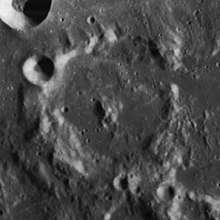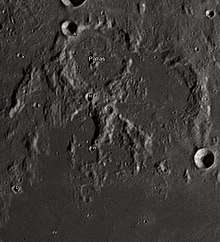Pallas (crater)
Pallas is a heavily eroded lunar impact crater located to the north of the Sinus Medii. It was named after the German-born Russian natural historian Peter Simon Pallas.[1] To the northwest is the smaller but less worn crater Bode. Pallas shares a low wall with the crater Murchison that is attached to the southeast, and there are two gaps in the shared rim.
 Lunar Orbiter 4 image | |
| Coordinates | 5.5°S 1.6°W |
|---|---|
| Diameter | 50 km |
| Depth | 1.3 km |
| Colongitude | 2° at sunrise |
| Eponym | Peter Simon Pallas |
The outer wall of Pallas is worn, notched, and somewhat distorted in shape. The associated crater Pallas A lies across the northwest rim. The inner floor of Pallas has been flooded by lava, leaving a relatively flat surface. The crater possesses a central peak complex.
Lunar flare
On November 15, 1953, the physician and amateur astronomer Dr. Leon H. Stuart took a picture of the Moon that appeared to show a flare of light about 16 km southeast of Pallas. The flare was estimated to last for about 8–10 seconds. The report was published in a 1956 issue of The Strolling Astronomer, a newsletter. However the incident was dismissed by professionals of the period as more likely a meteoroid entering the Earth's atmosphere.
Many years later Dr. Bonnie Buratti of JPL saw the photograph and decided to investigate. Assisted by a graduate student, she identified a 1.5 km. diameter crater imaged by the Clementine spacecraft. The crater has the correct size, shape, and albedo to match the expected impact energy. Some astronomers now agree that Dr. Stuart may indeed have photographed an asteroid impact on the Moon.[2]
Satellite craters

By convention these features are identified on lunar maps by placing the letter on the side of the crater midpoint that is closest to Pallas.
| Pallas | Latitude | Longitude | Diameter |
|---|---|---|---|
| A | 6.0° N | 2.3° W | 11 km |
| B | 4.2° N | 2.6° W | 4 km |
| C | 4.5° N | 1.1° W | 6 km |
| D | 2.4° N | 2.6° W | 4 km |
| E | 4.0° N | 1.4° W | 26 km |
| F | 3.4° N | 1.3° W | 18 km |
| H | 4.6° N | 1.5° W | 5 km |
| N | 7.0° N | 0.5° E | 6 km |
| V | 1.7° N | 1.5° W | 3 km |
| W | 3.6° N | 1.3° W | 3 km |
| X | 5.2° N | 3.2° W | 3 km |
References
- "Pallas (crater)". Gazetteer of Planetary Nomenclature. USGS Astrogeology Research Program.
- Buratti, B. J.; Johnson, L. L. (2003). "Identification of the lunar flash of 1953 with a fresh crater on the Moon's surface". Icarus. 161: 192–197. Bibcode:2003Icar..161..192B. doi:10.1016/S0019-1035(02)00027-1.
- Andersson, L. E.; Whitaker, E. A. (1982). NASA Catalogue of Lunar Nomenclature. NASA RP-1097.CS1 maint: ref=harv (link)
- Bussey, B.; Spudis, P. (2004). The Clementine Atlas of the Moon. New York: Cambridge University Press. ISBN 978-0-521-81528-4.CS1 maint: ref=harv (link)
- Cocks, Elijah E.; Cocks, Josiah C. (1995). Who's Who on the Moon: A Biographical Dictionary of Lunar Nomenclature. Tudor Publishers. ISBN 978-0-936389-27-1.CS1 maint: ref=harv (link)
- McDowell, Jonathan (July 15, 2007). "Lunar Nomenclature". Jonathan's Space Report. Retrieved 2007-10-24.CS1 maint: ref=harv (link)
- Menzel, D. H.; Minnaert, M.; Levin, B.; Dollfus, A.; Bell, B. (1971). "Report on Lunar Nomenclature by the Working Group of Commission 17 of the IAU". Space Science Reviews. 12 (2): 136–186. Bibcode:1971SSRv...12..136M. doi:10.1007/BF00171763.CS1 maint: ref=harv (link)
- Moore, Patrick (2001). On the Moon. Sterling Publishing Co. ISBN 978-0-304-35469-6.CS1 maint: ref=harv (link)
- Price, Fred W. (1988). The Moon Observer's Handbook. Cambridge University Press. ISBN 978-0-521-33500-3.CS1 maint: ref=harv (link)
- Rükl, Antonín (1990). Atlas of the Moon. Kalmbach Books. ISBN 978-0-913135-17-4.CS1 maint: ref=harv (link)
- Webb, Rev. T. W. (1962). Celestial Objects for Common Telescopes (6th revised ed.). Dover. ISBN 978-0-486-20917-3.CS1 maint: ref=harv (link)
- Whitaker, Ewen A. (1999). Mapping and Naming the Moon. Cambridge University Press. ISBN 978-0-521-62248-6.CS1 maint: ref=harv (link)
- Wlasuk, Peter T. (2000). Observing the Moon. Springer. ISBN 978-1-85233-193-1.CS1 maint: ref=harv (link)
External links
| Wikimedia Commons has media related to Pallas (crater). |
- Pallas at The Moon Wiki
- Wood, Chuck (November 2, 2006). "Move Over Orbiter". Lunar Photo of the Day. Archived from the original on June 14, 2011.
- Wood, Chuck (August 12, 2006). "Rimae Weird". Lunar Photo of the Day. Archived from the original on June 14, 2011. - also appeared on the August 24, 2004 LPOD
- Wood, Chuck (April 24, 2006). "Rubbly Lineations". Lunar Photo of the Day. Archived from the original on June 14, 2011.
- Wood, Chuck (April 8, 2010). "Textured Ejecta". Lunar Photo of the Day. - Rimae Bode, also includes Pallas crater